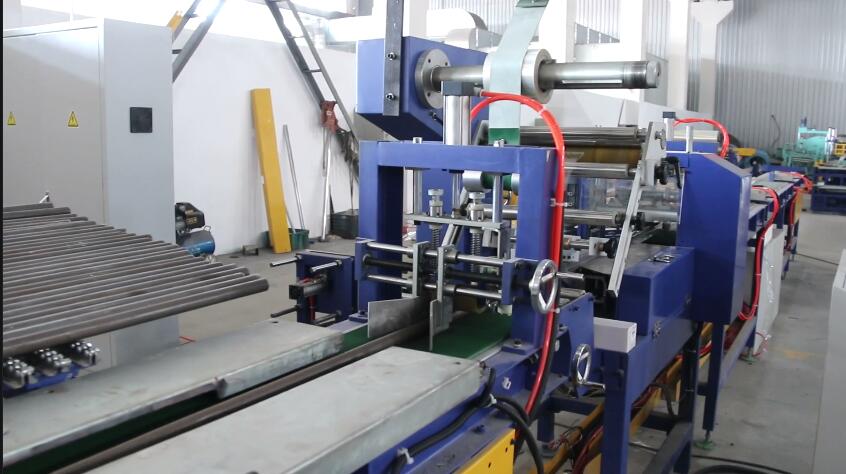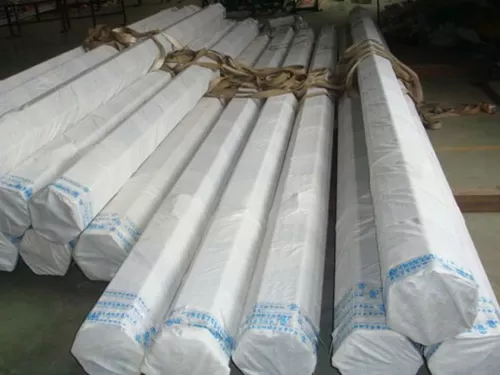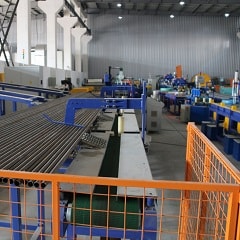1. Maximizing ROI with Trunking Bagging Machines: A Comprehensive Guide
In today's competitive manufacturing landscape, optimizing efficiency and cost-effectiveness is crucial. Businesses constantly seek innovative solutions to streamline operations and maximize their return on investment (ROI). One significant innovation in the packaging sector is the trunking bagging machine, also known as a trunking packaging machine. This guide provides an in-depth look at how these automated packaging systems can enhance your ROI, revolutionize your packaging process for long products, and provide a competitive advantage.
2. Understanding Trunking Bagging Machines
Before exploring the ROI benefits, let's clarify what a trunking bagging machine is and its operational principles. A trunking bagging machine is specialized automated equipment designed for packaging long, often cylindrical or profiled items. Common examples include:
- PVC or metal electrical trunking
- Pipes and conduits
- Architectural profiles and trims
- Metal extrusions
- Tubing
These machines are indispensable in industries like construction, electrical supply, plumbing, window/door manufacturing, and automotive component production.
Key features typically include:
- Automated Feeding System: Efficiently introduces products into the packaging cycle.
- Variable Bag Sizing: Automatically adjusts bag length based on the product, minimizing material waste. Film width is usually set based on the product range.
- High-Speed Sealing: Creates secure, clean seals using heat or ultrasonic methods.
- Integrated Cutting System: Precisely cuts the bagging film to the required length.
- User-Friendly HMI (Human-Machine Interface): Allows for straightforward operation, recipe management, and parameter adjustments.
By automating the packaging of these often unwieldy items, trunking bagging machines deliver substantial improvements in speed, consistency, and overall efficiency compared to manual methods.
3. The ROI Equation: Investing in Automated Packaging Efficiency
Evaluating any capital equipment investment inevitably focuses on ROI. For trunking packaging machines, the potential for a significant and relatively rapid return is a key driver for adoption. Let's break down the factors contributing to this compelling ROI:
3.1. Increased Productivity and Throughput
The most immediate impact of implementing a trunking bagging machine is a dramatic surge in packaging speed and overall throughput. Manually bagging long items is inherently slow, inconsistent, and labor-intensive. An automated trunking bagger can often achieve speeds such as:
- 5-15 cycles per minute, depending on product length, complexity, and machine configuration.
Compared to manual packaging rates (often 1-2 pieces per minute at best), the productivity leap is substantial. This increased output enables faster order fulfillment, reduces lead times, accommodates higher production volumes, and creates capacity for business growth.
3.2. Labor Cost Reduction and Reallocation

While the initial investment requires capital outlay, the reduction in manual labor costs provides a strong payback. A single automated bagging system can frequently perform the work of several manual packers. This yields savings not only in direct wages but also in associated costs:
- Recruitment and training expenses
- Employee benefits and insurance
- Reduced risk of repetitive strain injuries and associated claims
Furthermore, automating the packaging process allows valuable human resources to be redeployed to tasks requiring more skill or judgment, such as quality control, machine supervision, or upstream/downstream process improvements, enhancing overall operational value.
3.3. Packaging Material Savings
Trunking bagging machines excel at optimizing packaging material usage. By precisely measuring product length and creating bags accordingly ('bag-on-demand'), they significantly reduce film waste compared to using pre-made bags or less controlled manual wrapping. Typical material savings can range from 10% to 30% or more, depending on the previous method and product variability.
Additionally, the consistent tension and secure sealing provided by automation may allow for the use of thinner gauge films without compromising package integrity, leading to further cost reductions.
3.4. Enhanced Packaging Quality and Consistency
Manual packaging of long items often results in inconsistent presentation, variable seal quality, and potential product damage. Trunking bagging machines ensure:
- Uniform bag appearance: Consistent bag lengths and neat seals enhance product presentation.
- Reliable seal integrity: Protects products from dust, moisture, and scratches during handling and storage.
- Consistent material tension: Prevents loose bagging that can snag or tear.
These quality improvements translate into tangible benefits:
- Reduced product damage during transit and storage.
- Fewer customer complaints and returns related to packaging.
- Enhanced brand perception due to professional packaging.
- Improved handling efficiency in warehousing and logistics.
3.5. Reduced Overall Packaging Time
Speeding up the packaging process compresses the entire order fulfillment cycle. The time saved translates directly into:
- Faster turnaround times from production completion to shipping.
- Increased flexibility to handle urgent orders.
- Reduced bottlenecks in the end-of-line process.
- Improved on-time delivery performance.
By optimizing this critical step, businesses can improve overall operational agility and customer satisfaction.
4. Case Study Example: Calculating ROI for a Trunking Bagger
Let's illustrate the potential ROI with a hypothetical example:
- Company: Profile Extrusions Ltd.
- Product: Aluminum profiles (2-meter lengths)
- Current Method: Manual bagging with 4 workers, packaging 800 profiles per 8-hour shift.
- Proposed Solution: Trunking bagging machine ($120,000 investment).
Analysis:
| Parameter | Manual Method (Daily) | Automated Method (Daily) | Daily Difference |
|---|---|---|---|
| Labor Cost | 4 workers * $160 = $640 | 1 operator * $180 = $180 | -$460 (Saving) |
| Material Cost | $300 | $240 (20% saving) | -$60 (Saving) |
| Output (Profiles) | 800 | 2400 (Est. 3x increase) | +1600 |
| Total Daily Saving | $520 | ||
| Value of Addl. Output | $1600 (Assume $1 profit/unit) | ||
| Total Daily Benefit | $2120 |
Payback Calculation:
- Investment: $120,000
- Daily Benefit: $2120
- Payback Period: $120,000 / $2120 ≈ 57 working days (approx. 2.8 months)
Note: This is a simplified example. Actual ROI calculations should include factors like maintenance, energy costs, depreciation, and potential financing costs.
Even with conservative estimates, the payback period is often less than a year, after which the machine generates significant ongoing savings and profit contributions.
5. Selecting the Right Trunking Packaging Machine for Optimal ROI

Choosing the most suitable machine is critical for achieving the projected ROI. Consider these factors:
5.1. Production Volume and Speed Requirements
Analyze your current and anticipated future production volumes. Select a machine with a speed rating that comfortably exceeds your peak requirements to allow for growth and avoid bottlenecks.
5.2. Product Range and Dimensions
Evaluate the diversity of products you need to package:
- Length Range: Ensure the machine can handle your shortest and longest items.
- Diameter/Profile Size: Check the maximum cross-sectional dimensions the machine accommodates.
- Material Handling: Confirm compatibility with your product materials (e.g., PVC, aluminum, wood).
- Changeover Time: If you frequently switch between different product sizes, look for machines with quick and easy changeover features.
5.3. Integration with Existing Line
Consider how the machine will fit into your workflow:
- Infeed/Outfeed Compatibility: Ensure seamless connection with upstream (e.g., extrusion line, cutting station) and downstream (e.g., labeling, palletizing) equipment.
- Automation Level: Determine the required level of automation – from semi-automatic loading to fully integrated robotic handling.
- Data Integration: Explore options for connecting the machine to MES or ERP systems for production tracking and reporting.
5.4. Manufacturer Support and Reliability
Long-term ROI depends on machine uptime and support:
- Build Quality and Durability: Assess the machine's construction and component quality.
- Warranty and Service: Understand the warranty terms and the availability of local technical support and spare parts.
- Training: Ensure the manufacturer provides comprehensive operator and maintenance training.
- Reputation: Research the manufacturer's track record and customer reviews. [Consider linking to relevant industry forums or review sites if appropriate and available].
5.5. Future-Proofing Considerations
Invest with an eye toward the future:
- Software Upgradability: Can the control system be updated with new features?
- Modularity: Does the design allow for future additions, like automated loading or printing units?
- Material Compatibility: Can it handle emerging sustainable or advanced packaging films?
6. Implementing Your Trunking Bagging Machine Effectively
Successful implementation is key to realizing the full ROI potential. Follow these steps:
6.1. Pre-Installation Planning
- Site Assessment: Verify adequate floor space, ceiling height, and accessibility.
- Utility Requirements: Ensure correct power supply (voltage, phase), compressed air (pressure, volume), and any network connections are available.
- Layout Optimization: Plan the machine placement for optimal material flow and operator access.
- Foundation: Check if any special foundation or leveling is required.
6.2. Comprehensive Staff Training
- Operator Training: Focus on machine operation, parameter settings, safety procedures, and basic troubleshooting.
- Maintenance Training: Equip maintenance staff with knowledge of preventative maintenance schedules, lubrication, common wear parts, and diagnostic procedures.
- Cross-Training: Train multiple personnel to ensure operational continuity.
- Documentation: Develop clear Standard Operating Procedures (SOPs).
6.3. Commissioning and Calibration
- Initial Test Runs: Start with controlled runs using actual products to fine-tune settings (seal temperature, time, cutting parameters).
- Performance Verification: Gradually ramp up speed while monitoring package quality and machine performance.
- Recipe Saving: Document and save optimal machine settings for each product type.
6.4. Continuous Improvement Cycle
- Performance Monitoring: Regularly track key metrics (output rate, uptime, material usage, waste).
- Operator Feedback: Solicit input from operators on potential improvements or issues.
- Preventative Maintenance: Strictly adhere to the recommended maintenance schedule.
- Stay Informed: Keep abreast of manufacturer updates, software enhancements, or new best practices.
7. Overcoming Potential Implementation Challenges

Anticipate and address common hurdles:
7.1. Staff Resistance to Automation
- Communicate Benefits: Clearly explain how the machine improves safety, reduces tedious manual labor, and contributes to company success.
- Involve Staff: Include operators in the selection or implementation feedback process where possible.
- Emphasize Skill Enhancement: Frame the change as an opportunity to learn new, valuable skills in operating advanced machinery.
- Provide Reassurance: Address concerns about job security through clear communication about role changes or reallocation.
7.2. Initial Learning Curve and Productivity Dip
- Realistic Expectations: Understand that achieving peak performance takes time.
- Phased Rollout: Implement gradually if feasible, running the machine alongside manual methods initially.
- Ongoing Support: Ensure operators have easy access to support during the initial weeks.
- Celebrate Milestones: Acknowledge progress and successes to build confidence.
7.3. Adapting Maintenance Procedures
- Proactive Planning: Integrate the new machine into your existing Computerized Maintenance Management System (CMMS) or maintenance schedules.
- Spare Parts Strategy: Identify critical spare parts and maintain appropriate inventory levels.
- Utilize Manufacturer Resources: Leverage technical support hotlines, manuals, and online resources provided by the manufacturer.
8. Future Trends in Trunking Packaging Technology
Staying informed about technological advancements helps maximize long-term ROI:
8.1. Enhanced Connectivity (IIoT)
- Remote Monitoring: Access machine status and performance data from anywhere.
- Predictive Maintenance: Sensors and analytics anticipate potential failures, allowing proactive servicing.
- Cloud Integration: Seamless data sharing with other business systems.
8.2. Sustainability Focus
- Recycled/Bio-based Film Compatibility: Machines designed or adapted to run effectively with eco-friendly packaging materials.
- Energy Efficiency: Motors, heaters, and pneumatic systems designed for reduced energy consumption.
- Optimized Material Usage: Advanced controls further minimize film waste.
8.3. Increased Automation and Robotics
- Robotic Loading/Unloading: Fully automated integration with production lines.
- AI-Powered Optimization: Systems that learn and self-adjust parameters for optimal performance based on real-time conditions.
- Automated Quality Control: Integrated vision systems for detecting defects in products or packaging.
8.4. Greater Customization and Flexibility
- Integrated Printing: In-line printing of logos, barcodes, or product information directly onto the bag.
- Adaptive Systems: Machines capable of automatically adjusting to variations in product dimensions without manual intervention.
- Modular Designs: Easily add or change modules for different functions (e.g., labeling, hole punching).
9. Measuring and Continuously Maximizing Your ROI
Achieving ROI is not a one-time event; it requires ongoing effort:
- Track Key Performance Indicators (KPIs):
- Overall Equipment Effectiveness (OEE = Availability x Performance x Quality)
- Throughput (units packaged per hour/shift)
- Material Yield (film used vs. theoretical minimum)
- Downtime (planned and unplanned)
- Labor Cost per Unit Packaged
- Regular Reviews: Analyze KPI trends to identify opportunities for optimization.
- Benchmarking: Compare performance against industry standards or previous manual methods.
- Feedback Loops: Continuously gather input from operators, maintenance, and quality teams.
10. Conclusion: Investing in Efficiency for Sustainable Growth
Investing in a trunking bagging machine represents a strategic move towards enhanced operational efficiency and profitability. By automating the packaging of long, challenging products, these machines deliver compelling ROI through increased productivity, reduced labor and material costs, and improved package quality.
While the initial investment requires careful consideration, the potential for rapid payback and substantial long-term savings makes automated trunking packaging solutions a vital tool for manufacturers in relevant sectors. Success hinges on selecting the right machine, implementing it effectively, providing thorough training, and committing to ongoing performance monitoring and optimization.
Ultimately, adopting this technology is an investment in competitiveness, efficiency, and the future sustainability of your manufacturing operation. It empowers businesses to meet market demands, improve customer satisfaction, and achieve significant growth.